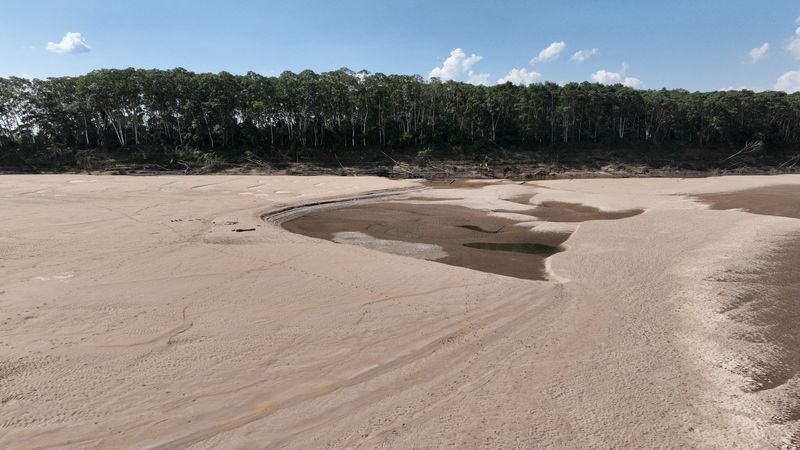
By Lisandra Paraguassu
BRASILIA (Reuters) – Last year’s record drought in the Amazon (NASDAQ:AMZN) and less than usual rainfall since caused river water levels to drop rapidly, hindering navigation by barges carrying grains for export and cutting off communities that depend on river transport.
The Brazilian Geological Service (SGB) has warned that water levels have been falling since June and all rivers in the Amazon basin are expected to drop below their historical levels.
In Manaus, the Rio Negro river is 21 meters deep, down from 24 meters at the same time in 2023, which is beginning to worry industries in the Free Trade Zone, where businesses have requested dredging work begin on the river to avoid last year’s disruption of transport.
Dredging has started on critical points of the Madeira river where only low-draft vessels are able to pass, according to the government’s department of transport infrastructure DNIT. Dredging work is being contracted for the major Amazon and Solimoes rivers, DNIT said.
Following last year’s drought, barges were prevented from using some ports on the Amazon river, and the outlook for this year is even worse, said consultancy ARGUS.
“This could lead to the redirecting of grain and fertilizer cargoes in the coming months to Itaqui and other ports in the south and southeast of Brazil,” ARGUS said in a study that forecasts increased shipping costs for producers.
In Porto Velho, Rondonia state, the Madeira River has been below two meters since July, when its normal depth is 5.3 meters, the SGB said. The river has two hydroelectric dams, Jirau and Santo Antonio, and transportation is impacted on one of the main waterways for the north of Brazil.
Across the Amazon region, communities are facing isolation due to lower river navigability. Residents cannot travel to buy food, and crops are being harmed, besides the fish that are killed when streams dry up, hurting riverside communities that live from fishing.
“In normal droughts, the rivers have enough volume to carry food, small boats. But not now. They have dried up and people are being isolated,” said climatologist Jose Marengo.
More rain had been expected in the second half of this year thanks to the La Niña phenomenon cooling the waters of the Pacific near the Equator, which should bring more humidity in northern Brazil and dried weather to the south.

This year, however, the waters of the Pacific have not cooled as expected, which combined with the lack of rain in 2023, has led to a catastrophic situation in the Amazon, said Marengo, coordinator of Research and Development at the National Center for Natural Disaster Monitoring and Alerts (Cemaden).
The lack of rain in the Amazon will deprive areas to the south of moisture through the “flying rivers” that take water vapor rising from the rainforest to the savannah region below the Amazon and further to southern Brazil, said Marengo, who helped coin the term for the invisible currents of humid air.
This post is originally published on INVESTING.




